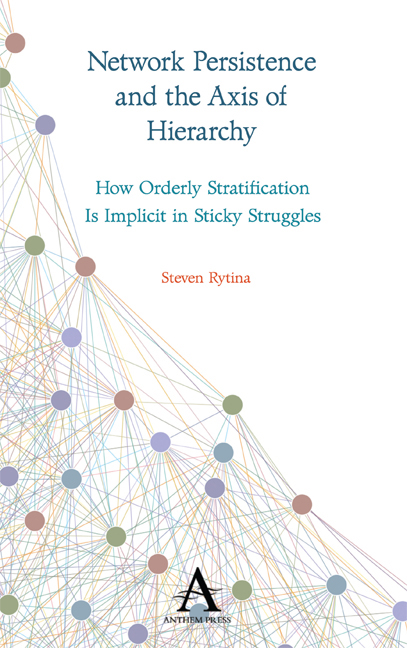 Network Persistence and the Axis of Hierarchy
Network Persistence and the Axis of Hierarchy Book contents
- Frontmatter
- Contents
- List of Illustrations
- Preface
- Chapter One Sticky Struggles: The Unified Pattern of Social Ranks Inherent in Networks
- Chapter Two Foundations of Cacophony
- Chapter Three Knots of Regularity
- Chapter Four Hierarchy: Inevitable but Inevitably Messy
- Chapter Five The Inevitable Emergence of Stratification
- Chapter Six Scaling Intergenerational Continuity: Is Occupational Inheritance Ascriptive After All?
- Chapter Seven Taming the Mobility Table
- Chapter Eight Is Occupational Mobility Declining in the United States?
- Chapter Nine The Continuum of Class over Time: Deconstructing Imposed Class to Uncover Empirical Classes
- Chapter Ten Concluding Reflections
- Appendix Why Robust Attraction Is (Effectively) Inevitable for Mobility Data
- Index
Chapter Four - Hierarchy: Inevitable but Inevitably Messy
Published online by Cambridge University Press: 30 April 2020
- Frontmatter
- Contents
- List of Illustrations
- Preface
- Chapter One Sticky Struggles: The Unified Pattern of Social Ranks Inherent in Networks
- Chapter Two Foundations of Cacophony
- Chapter Three Knots of Regularity
- Chapter Four Hierarchy: Inevitable but Inevitably Messy
- Chapter Five The Inevitable Emergence of Stratification
- Chapter Six Scaling Intergenerational Continuity: Is Occupational Inheritance Ascriptive After All?
- Chapter Seven Taming the Mobility Table
- Chapter Eight Is Occupational Mobility Declining in the United States?
- Chapter Nine The Continuum of Class over Time: Deconstructing Imposed Class to Uncover Empirical Classes
- Chapter Ten Concluding Reflections
- Appendix Why Robust Attraction Is (Effectively) Inevitable for Mobility Data
- Index
Summary
The next step in the minimalist program is to link occupation with hierarchy.
Occupation could be regarded as some sort of intersection of the network concepts reviewed in Chapter 3. Prominent among the gatherings that one is included in or excluded from are those where productive activity— work— regularly occurs. The workteams of divided labor commonly define slots, and therefore suitable replacements, using the language of occupation, albeit often in much finer detail than occupational coding captures. As a result of the foregoing, a substantial fraction of many sticky networks will be restricted to one or a few occupations.
The most that the minimalist program requires, strictly construed, is almost trivial. A directional arrow needs to be attached to local rules that distinguishes up from down. This is a preamble to the formal derivation of an emergent dimension to be presented in the next chapter. Attaching direction patches a modest hole: the formalism is symmetrical and does not spell out which end is up. But it is unlikely that any real doubt exists about what counts for “up” in stratification.
There is no real doubt because all extant accounts of occupation and hierarchy converge in rough outline. Yet divergence sets in at some indefinite juncture, of finer detail, of more exacting conceptualization, or difference in principal causes. On any account, physicians outrank plowmen, but contrary resolutions appear when finer details are addressed.
This sets the stage for attempting to carve out some common ground. The basis for this attempt is the minimalist sketch of the previous chapter. This synthesis— featuring the ubiquity of stable local unequal arrangements— is analytically sufficient to generate the principal axis of stratification to be outlined in the next chapter. That motivates the central problems of this chapter.
A review of leading examples will show how the network concepts are compatible, implicit, or otherwise consistent with a wide range of alternative theoretical stances on occupations and hierarchy. That is, none are ruled out; hence, none are contradicted and cacophony can be avoided.
This is accomplished by showing that each older account can be shown to be a restricted, special case obtained by imposing further universal propositions, that is, some Global Rules.
- Type
- Chapter
- Information
- Network Persistence and the Axis of HierarchyHow Orderly Stratification Is Implicit in Sticky Struggles, pp. 91 - 126Publisher: Anthem PressPrint publication year: 2020


